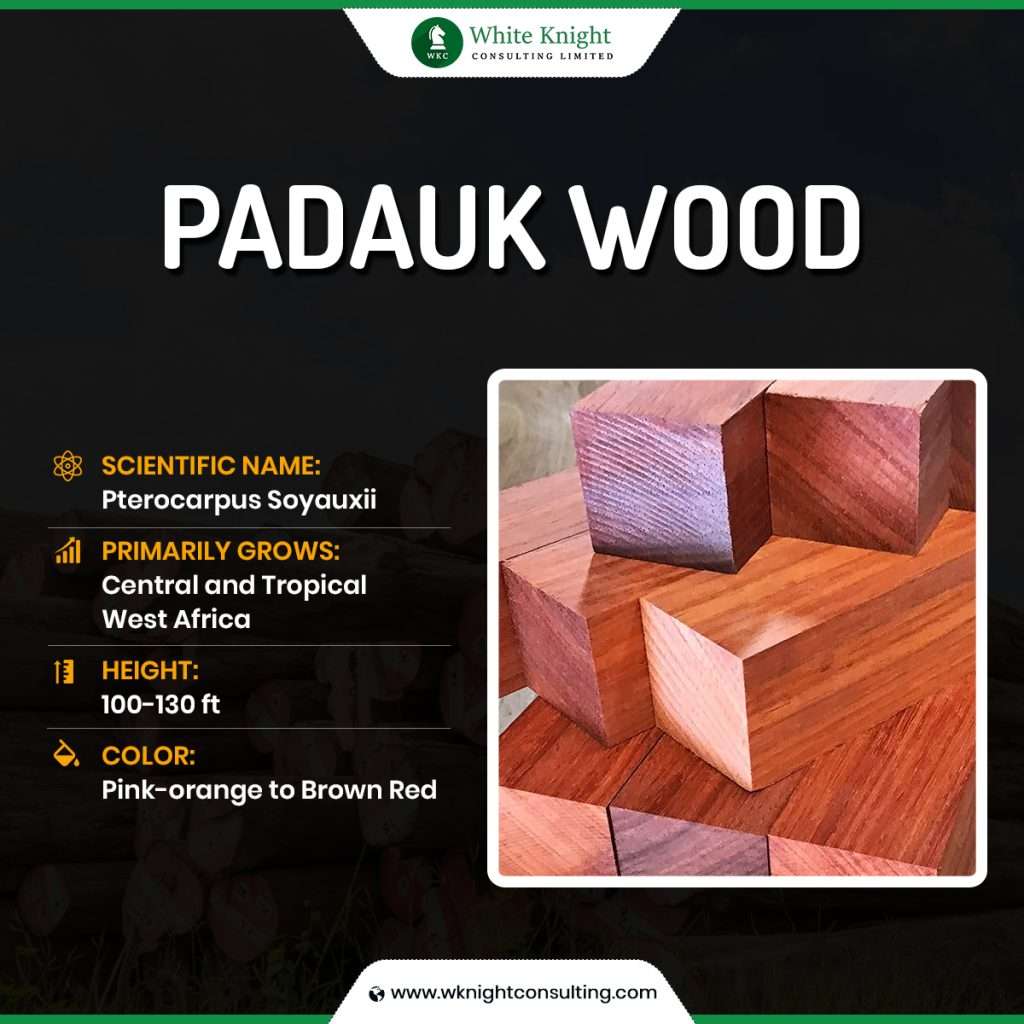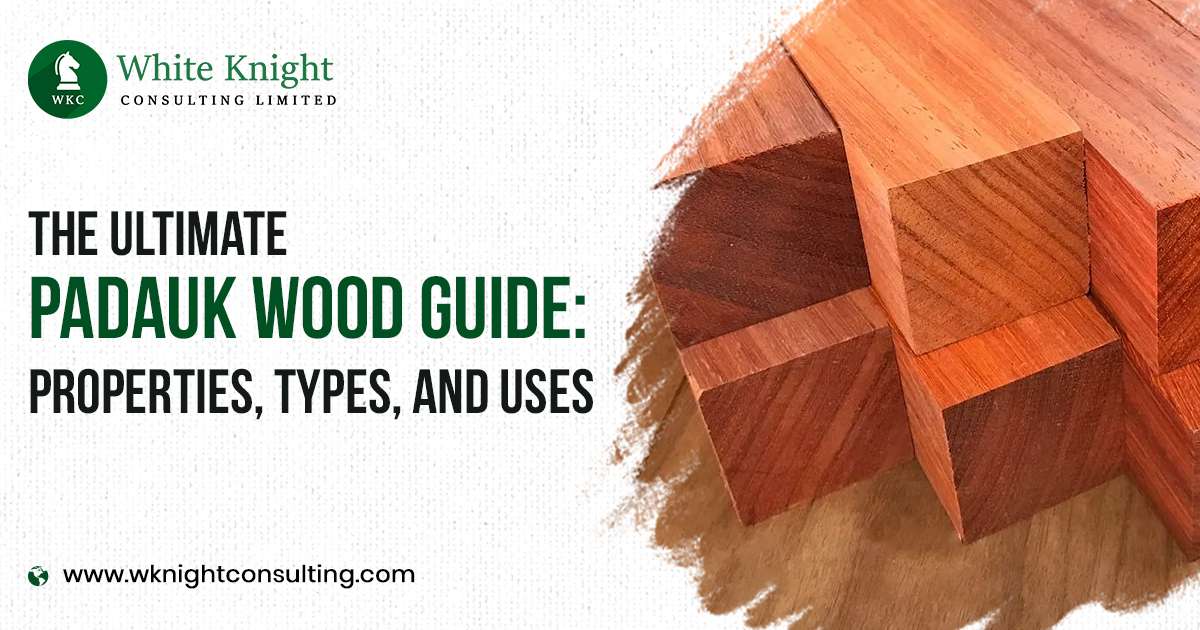Padauk is a hardwood of the Pterocarpus genus. Padauk has many species, of which African Padauk is the most famous. It is a brownish red colour wood with good natural strength and durability.
Different species of Padauk have different properties and appearances, though all have similar use cases. Padauk wood is particularly famous for its excellent decay resistance, which makes it a wonderful choice for outdoor uses. It is a versatile wood with many applications across commercial, construction, crafting, interior and other industries.
If you are looking for high-quality Padauk wood for sale? or are curious about the properties, types & uses of Padauk wood, here’s everything you need.
What Is Padauk Wood?
African Padauk or Vermillion is a hardwood that is native to Central and tropical West Africa. Padauk trees are about 100-130 ft (30-40 m) tall and have a 2-4 ft (.6-1.2 m) trunk diameter.
Padauk is considered an exotic wood because of its extraordinary appearance and outstanding strength and natural durability.
It is a popular choice among woodworking hobbyists and crafters because of its unique and amazing appearance and lower cost than many other exotic woods. Padauk is just dense enough for use in heavy-duty applications where the wear and tear of wood can be a concern, yet it is not very difficult to work with.
In different regions, you might come across different names or spellings of Padauk, the most popular of which include padouk, paduk, and paduak.
The three most popular species of padauk are African Padauk, Andaman Padauk, and Burma Padauk.
Types of Padauk
Padauk is a term used for various hardwood species belonging to the Pterocarpus genus. The three most common and popular types of padauk include:
African Padauk (Pterocarpus soyauxii): Native to West and Central Africa, this is also known as Vermilion because of its unique, vibrant reddish-orange colour that deepens or fades over time. It’s a strong, durable and stable wood.
Andaman Padauk (Pterocarpus dalbergioides): Found mainly in the Andaman Islands (India), this padauk species can be identified by its distinctive bright orange-red colour. It is famous for its durability and workability.
Burmese Padauk (Pterocarpus macrocarpus): Sourced from Myanmar (formerly Burma), and Thailand, this wood has a deep reddish-brown hue that darkens with age. It is a strong, heavy and durable wood.
The different types of padauk wood have their unique appearance, qualities and pros & cons, which make them suitable for different and a wide range of woodworking applications.
Padauk Wood Properties & Physical Characteristics

Appearance
Among all the things about Padauk, its appearance is probably its most unique characteristic. Freshly-cut padauk has a very unique reddish-orange hue, which can darken over time and with age into deeper reddish/purplish brown or greyish brown. It generally has dark grey steaks. Unlike African and Andaman Padauk, Burma Padauk comes only in a reddish-brown hue without an orange shade.
Padauk is often finished with UV finishes to prevent or delay the shift of colour over time to maintain its natural appearance.
The grain in African Padauk is usually straight, while Andaman Padauk has an interlocked grain is not uncommon. The wood texture is coarse and it has good natural lustre. It has large open pores.
Weight & Density
Padauk is a moderately heavy wood with an average dried weight of 47 lbs/ft3 (745 kg/m3).
Padauk is a moderately dense wood such that it can be considered suitable for high-wear applications, yet it is not too dense to make it unduly challenging to work with.
Strength
Padauk is a strong and stiff wood with outstanding stability.
Hardness
With an exceptional Janka hardness rating of 1,970 lbf (8,760 N), padauk is one of the hardest woods out there.
Durability
Padauk is an excellent wood in terms of durability. It is rated as very durable and is naturally resistant to decay, rot, moisture, termites, and insects.
Workability
Padauk is generally easy to work with. The presence of interlocked grain can sometimes cause tearout when planing. To achieve a smooth surface, it may be required to fill the large open pores of Padauk wood first. It turns and glues really well and is also very easy to carve.
Padauk Pros & Cons
Advantages of Padauk
- Padauk wood is highly cherished for its beautiful appearance, giving an aesthetically pleasing maroon or purple-brown hue to the project. This makes Padauk a preferred choice for decorative uses.
- Padauk wood offers superior durability and dimensional stability and has good resistance to wear, rot, and decay.
- Its high tensile and turning strength make Padauk ideal for structural applications and construction.
- Padauk wood is also easy to work with, as it responds well to cutting and shaping, and carving can be done using both hand or power tools. It also accepts finishes, paints, and polishes well and the result is usually a smooth appearance.
- Padauk has great stability, which means it won’t be affected much by changes in humidity or moisture and is ideal for use in doors, windows, and outdoor applications.
- Padauk wood is rich in natural oils and resins, which allow it to be resistant to insects and fungi.
Disadvantages of Padauk
- Padauk wood is moderately expensive due to its high demand owing to its unique colour and outstanding properties
- Padauk wood is prone to fading to a greyish shade when exposed to sunlight for too long.
- Some individuals may encounter allergies such as respiratory irritation and skin rashes when working with padauk wood due to the dust generated during cutting or sanding the wood.
- Padauk is not as easily or readily available in all parts of the world.
- It is dense and can be heavier than other woods.
- Padauk wood’s high density and interlocked grain can sometimes cause blunting of cutting tools or result in tearout when planing.
Uses of Padauk Wood
Padauk is one of the most popular hardwoods because of its unique appearance and outstanding durability. It has many applications across various industries, including:
Furniture manufacturing: Because of its attractive appearance and durability, Padauk is considered a great choice for building high-quality furniture such as cabinets, tables, chairs, bed frames, etc.
Flooring: Padauk is a hard, strong and dimensionally stable wood, which makes it suitable for flooring construction. It can be used in both residential and commercial settings.
Musical Instruments: Padauk wood is also known for its acoustic properties and is favoured for making musical instruments such as guitars, drums, and xylophones.
Cabinetry: Padauk wood offers tremendous strength and durability when used to make beautiful cabinets and shelves for kitchens, bathrooms, storage units, and more.
Decorative Items: Due to its vibrant appearance and unique grain patterns, padauk wood is also commonly used for making decorative items including sculptures, ornaments, turnings, carvings, and other speciality items.
Interior Millwork: Padauk wood is also favoured by woodworkers for creating beautiful millwork for doors, windows, mouldings, and interior trims.
Veneering: Padauk wood is strong, stable and beautiful, which makes it one of the best choices for creating thin wood sheets called veneers for use in furniture, cabinets, panelling, and more.
Construction: Its high tensile and turning strength makes Padauk ideal for structural applications and general construction.
Exterior Applications: Padauk is a durable wood with natural resistance to insects and decay, which makes it ideal for exterior applications such as outdoor furniture, decking, fences, and marine applications.
Speciality Wooden Items: Padauk wood is also commonly used for making specialty wooden items such as toys, kitchen tools, knife handles, turned bowls, cutting boards, tool handles, and pens.
Padauk Wood Availability and Price
African Padauk is exclusive to Central and tropical West Africa, from where it is imported to other parts of the world. It is commonly available as lumber in various lengths and thicknesses which is ready for use in commercial applications.
The availability of Padauk has, however, been decreasing in recent years due to growing demand and increasing scarcity in its native regions. The wood is also limited by trade restrictions in some areas.
The price of Padauk timber can be moderate to high depending on availability. Contact White Knight Consulting LTD for the best price for Padauk wood timber on wholesale orders.
